That Canter’s pastrami takeout you ordered might be coming from a ghost kitchen

- Share via
For much of its nearly nine decades of operation, Canter’s delicatessen has been slinging pastrami sandwiches, fried kippered herring and other traditional deli fare in a converted theater on Fairfax Avenue complete with vinyl booths and 1950s decor, topped with a neon glow.
Canter’s midcentury vibe has always been a draw, but in recent years its owners have seen an increase in customers who never make it in the door.
“If you are invisible in online platforms, you are going to go under,” said Marc Canter, leader of the four-generation family business, which launched in 1931. “You have to be there to survive.”
About a third of the deli’s orders now are sold to-go, Canter said. To better serve that growing business, he has expanded into shared commercial kitchens that extend the reach of Canter’s into Pasadena and West Los Angeles.
Such operations are known variously as ghost, virtual or cloud kitchens because they allow restaurateurs to serve customers without actually operating a restaurant.

These shared commercial kitchen spaces for rent primarily serve online customers and are a new category of commercial real estate that looked sexy to investors when the concept piqued widespread interest two years ago as a promising growth opportunity. Ousted Uber Technologies co-founder Travis Kalanick is one bold-faced name investing in the space.
So far, virtual kitchens have proved challenging to deliver in bricks and mortar — only three of the new-style operations exist in Los Angeles County.
But more are expected to follow as Americans grow increasingly fond of having their favorite foods handed to them at their front doors. Ordering online these days is nearly effortless, a great leap from a few years ago, Canter recalled, when it often took 10 minutes on the phone to write down a to-go order and collect credit card payment information.
Virtual kitchens were dreamed up to take the pressure off restaurant kitchens and avoid “disrupting the flow” of service to their seated customers, retail real estate broker Jim Crocenzi of CBRE said. “Now it’s a whole other business model.”
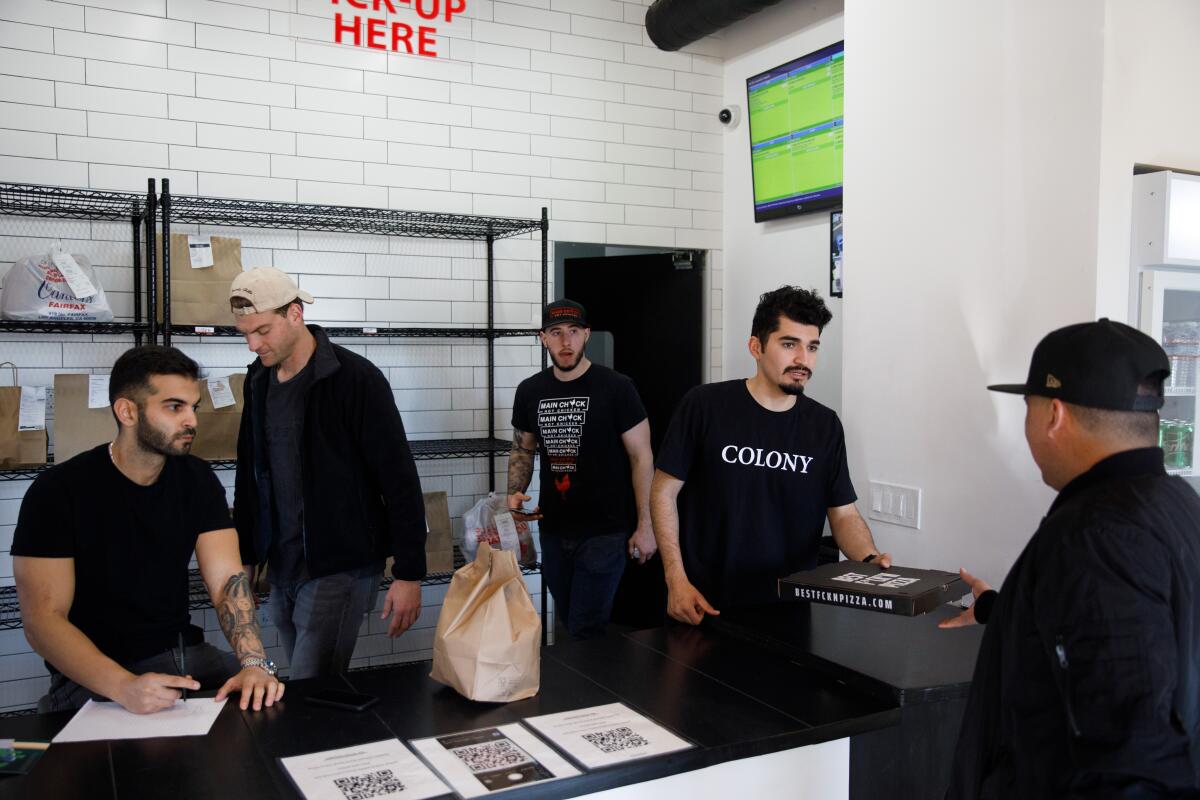
Delivery is considered to be “the new drive-through” by food industry leaders, the brokerage said. U.S. food-service delivery sales reached $34 billion in 2018, up 13% from the year before, according to a 2019 report by CBRE.
Restaurants are looking for more efficient ways to satisfy online-sourced hunger and are turning to virtual kitchens or shared meal preparation spaces to meet delivery demand, the report said.
Delivering food can be costly, however, and using third-party services such as Grubhub, Postmates and DoorDash comes with costs, including fees of as much as 30%, that restaurants often have to eat, Crocenzi said.
“Many restaurants say they are losing money or breaking even” on food delivery, he said, “but they feel like they have to be in that space.”

Some restaurants are retrofitting their kitchens to set up a separate line for to-go orders, Crocenzi said, while a few big players such as Chick-fil-A and Bloomin’ Brands — the parent of Outback Steakhouse — are experimenting with their own stand-alone remote kitchens that prepare only takeout and delivery orders.
But for others, including fledgling restaurants and old-line eateries such as Canter’s, becoming a tenant in a virtual kitchen that houses multiple brands under one roof is the option of choice.
A traditional restaurant can easily cost millions of dollars to build and open, while ghost kitchens can start up for as little as $20,000, CBRE said. Rent at a virtual kitchen can run about $5,000 to $7,000 a month.
Restaurateurs can move their gear in and start selling food within a matter of days or weeks, compared with the months of costly work it takes to build out a traditional restaurant and secure government permits to operate.
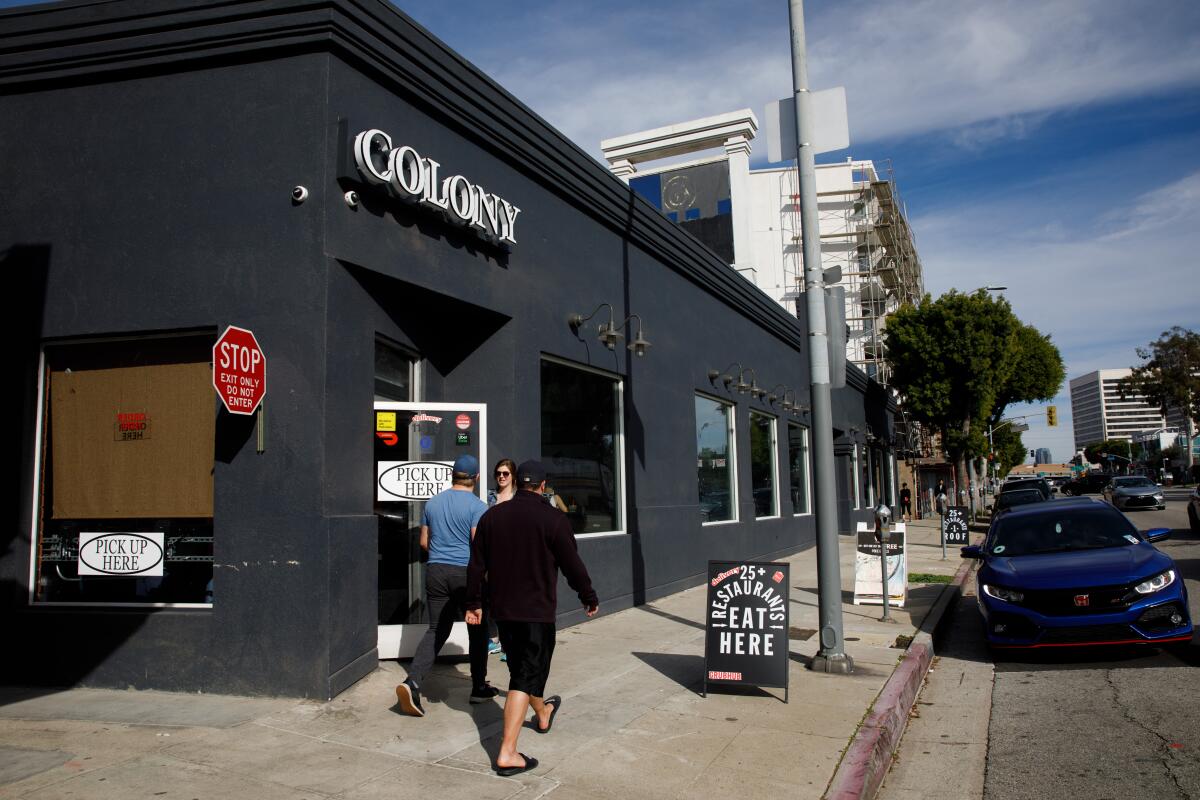
Landlords provide services such as maintenance and cleaning, locker rooms and technology platforms to handle electronic orders. Some units come equipped with stoves and ovens, while others have hookups ready for operators who bring their own.
Then there are the intangible benefits from working with like-minded entrepreneurs, Canter said.
“You’re neighbors, and you can work together,” he said. “You can borrow a head of lettuce or lend them an avocado.”
For Canter, his outposts in two virtual kitchens, Eats on Madison in Pasadena and Colony in West Los Angeles, are expansions that don’t require deep financial investments.
Each can run with two deli-trained employees working at a time. The kitchens use the same brisket, pastrami and other meats that fill sandwiches at the Fairfax restaurant on rye bread baked at “the mother ship,” as Canter calls it.

Canter also is using the virtual Canter’s kitchens to experiment with a new brand that exists only online.
“We have a ghost store called Grilled Cheese Heaven,” he said, which sells grilled cheese sandwiches along with burgers, salads and quesadillas.
“You’re already paying rent and labor,” Canter said. “Why not?”
For the young owners of Main Chick Hot Chicken, virtual kitchens offer a shot at culinary glory, the chance to lay the foundation for what they hope will become a national restaurant chain. Founded by a group of friends who grew up in the San Fernando Valley, Main Chick serves Nashville-style fried chicken in escalating degrees of spiciness.
They crowd five at a time into their kitchen at Colony, where they also prepare orders for their more established mini-chain Oi Asian Fusion.
The restaurateurs are planning Main Chick locations in Pasadena, Long Beach and Ontario and envision a host of fast-casual hot chicken restaurants spreading from California to other states.
“We are expanding very rapidly,” said chef Eric Dela Cruz, who came up with Main Chick’s spicy recipe and tested it at Asian night markets. “We’re very ambitious.”
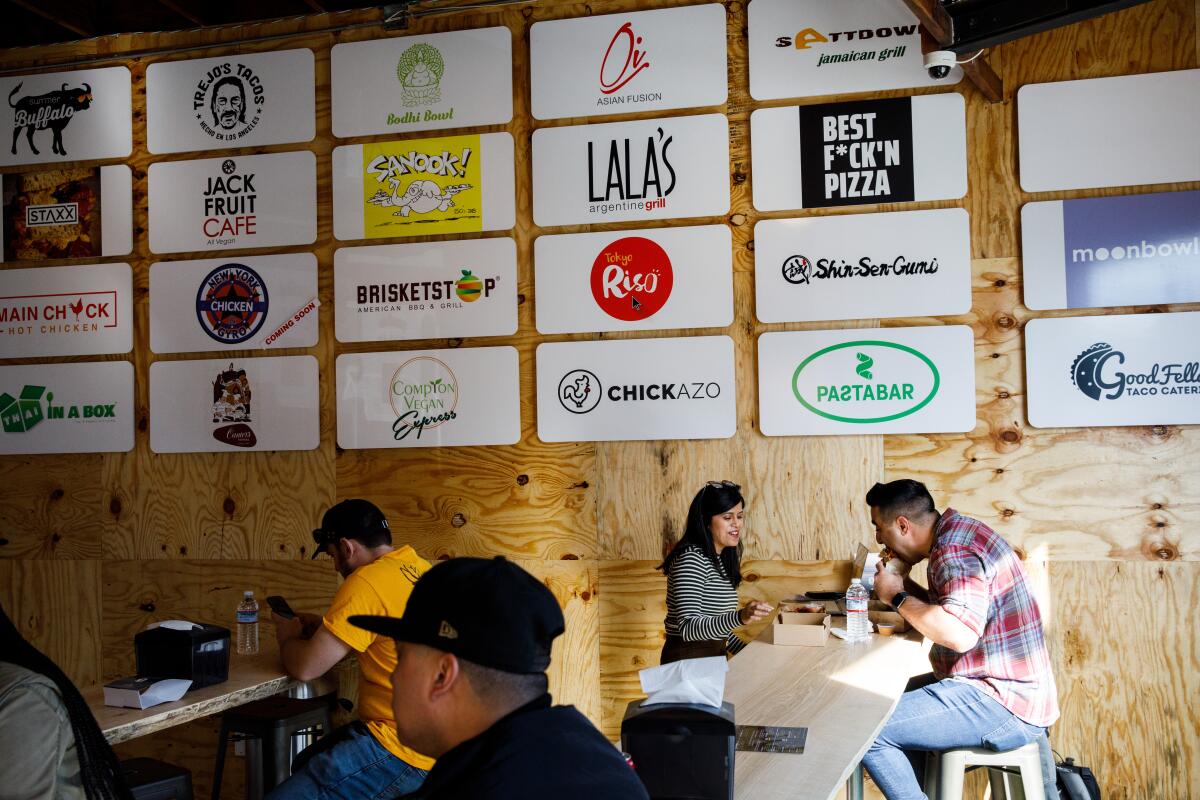
Main Chick and Canter’s occupy two of the 26 kitchen spaces at Colony, where they are subtenants of developer Dimitri Colupaev, who rents the Santa Monica Boulevard building from a family trust.
It’s a similar business model used by co-working office companies such as WeWork, which rent blocks of office space from big office landlords and sublet to small companies and individuals. Virtual kitchens are viewed by proponents as a new business frontier, melding real estate and research technology employed to make operations more efficient and responsive to consumers.
Kalanick, who quit Uber’s board in December, reportedly raised $700 million, including $400 million from Saudi Arabia’s sovereign wealth fund, to build a network called CloudKitchens. One of them is in a leased industrial building on Washington Boulevard in the Pico-Union district of Los Angeles west of downtown.
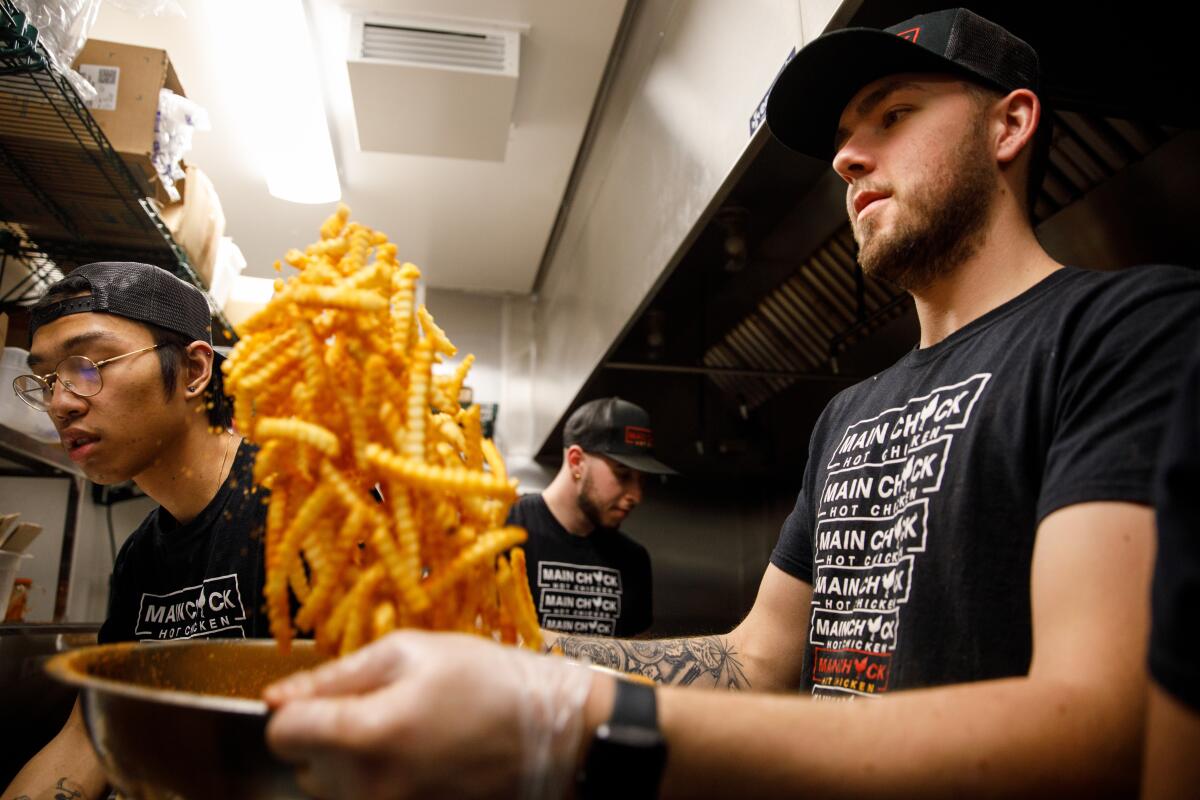
It’s one of the big three virtual kitchens in Los Angeles County and houses multiple restaurants. (CloudKitchens declined to comment on its business operations.)
Canter’s used to have a location at CloudKitchens but moved to West L.A in the hope it could reach more customers, Canter said.
Colony founder Colupaev and his partner Nicholas Popov are German immigrants who met as competitive swimmers — Colupaev received an athletic scholarship to USC and competed in the 2012 Olympics in London. He worked for Los Angeles-area real estate developers Kennedy Wilson and Hackman Capital Partners before venturing out on his own with Colony, which he and Popov hope will be the first of several cloud kitchens they operate.
The inspiration for Colony came from India, Colupaev said, where virtual restaurants such as Curry Me Up began to boom in late 2017, fueled by demand from tech-savvy millennials in Mumbai and other metropolitan centers.
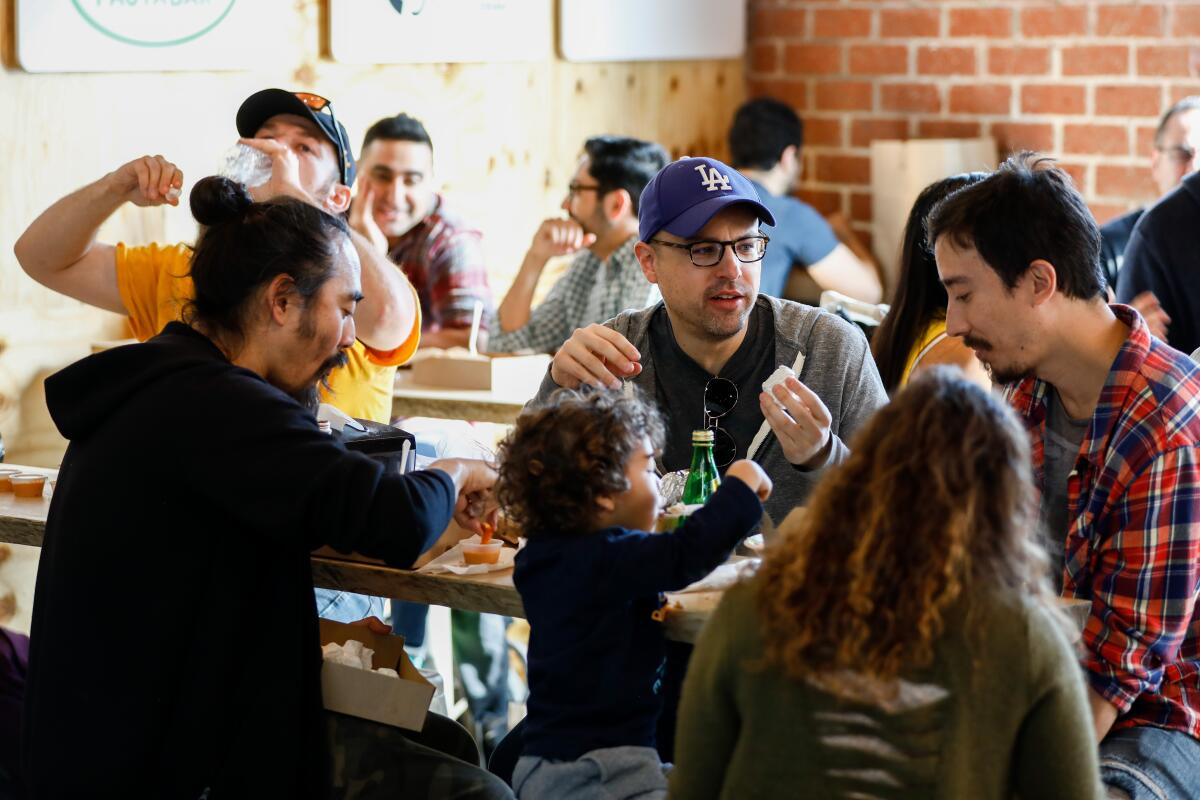
Colupaev found a former Ethan Allen furniture store at 11419 Santa Monica Blvd. that was last used as a studio by Lifetime television’s “Dance Moms” star Abby Lee Miller. He declined to reveal how much it cost to outfit the building as a ghost kitchen, a transformation that took nine months.
The typical kitchen is about 250 square feet, each behind a door off shared hallways. The roof is packed with individual ventilating and cooling systems that serve each unit.
“These buildings just don’t exist,” Colupaev said. “They have to be created.”

He estimates that about 100 people work at Colony, where a range of foods are served by restaurants such as Trejo’s Tacos, Sattdown Jamaican Grill and Lala’s Argentine Grill. It’s the home of Jackfruit Cafe, a vegan soul food restaurant operated by actress Angela Means Kaaya, known for playing Felisha in the 1995 movie “Friday.”
“It’s a colony of different cuisines from people of all kinds of backgrounds,” Colupaev said.
Finding good locations for ghost kitchens is a challenge, CBRE real estate broker David Freitag said, because they need to be near densely populated neighborhoods but not in prime retail locations where rents can be prohibitively high. Industrial kitchens often rented by caterers, for example, tend to be in manufacturing districts such as Vernon.
Pasadena’s Eats on Madison fits the ghost kitchen profile, located in a former Le Cordon Bleu cooking school a few blocks from Colorado Boulevard and Lake Avenue.
Opened in 2018, it was the first location for Kitchen United, a Pasadena company that has raised nearly $50 million in its quest to build a national empire that already includes kitchens in Chicago and Scottsdale, Ariz. It’s backed by GV, the venture arm of Google parent Alphabet Inc.
“We are a proud tech company,” said Joy Lai, who is in charge of data strategy. A primary goal of Kitchen United’s data science team is to identify unmet demand for cuisines in an area they want to serve and find restaurateurs to make it.
In Scottsdale, company researchers found, the cuisine in most demand is Asian, while the most popular growing cuisine is Indian. In beef-loving Austin, Texas, where a new kitchen center will open soon, the dish most in demand is hamburgers and most popular growing cuisine is steak.
Like Colony, Eats on Madison has a room in front where visitors can order from an electronic kiosk and sit down with their packaged food if they choose to eat it there.
“We think of ourselves as a virtual food hall,” Lai said.
More Kitchen United branches are in the works, including one on Pico Boulevard in downtown Los Angeles set to open this year. The goal is to open about 400 kitchen centers with a combined 5,000 kitchens. But it may take longer than the founders originally expected.
“Our first philosophy was go fast,” Lai said, but it turned out to be “much harder to build these things” than anticipated.
It’s a common challenge, CBRE’s Crocenzi said, because virtual kitchens are a new category of restaurant real estate.
“Zoning codes don’t anticipate these types of multi-suite kitchens,” he said, but they won’t be rare for long.
As popular as food delivery is, it hasn’t come close to peaking, Crocenzi said.
“This is a business growing rapidly and exponentially every year,” he said, “and shows no end.”
More to Read
Inside the business of entertainment
The Wide Shot brings you news, analysis and insights on everything from streaming wars to production — and what it all means for the future.
You may occasionally receive promotional content from the Los Angeles Times.











